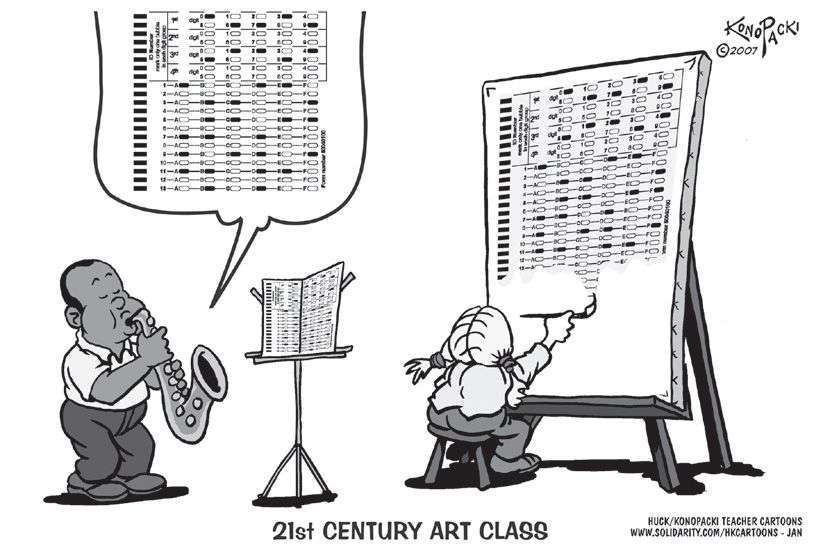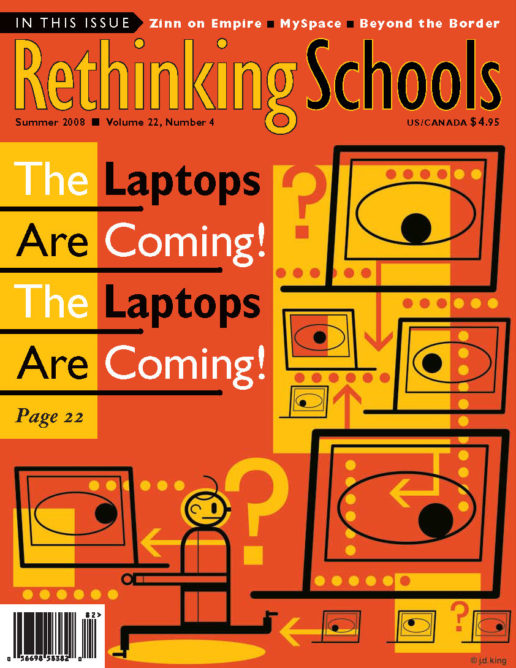Letters to the Editors 22.4

Purposeful Silence
I have been reading Rethinking Schools for twenty years, ever since I was a sole Asian American student in Bill Bigelow and Linda Christensen’s class at Jefferson High School, where I first learned to love writing and history. In fact, I learned to love it so much that I too became a writing teacher and am now working on a Ph.D. in composition and rhetoric. Given my own experience and what I have learned through my current research on the use of writing by Japanese Americans to survive and resist their incarceration during World War II, I wanted to respond to Carol Tateishi’s important article on the silence of Asian American students, “Taking a Chance with Words” (Vol. 22, No. 2).
Tateishi’s article raises two issues for me, the first of which is historical. Tateishi begins with a narrative about her father and his belief that the Nikkei (of Japanese heritage) community was “sold down the river” because they “lacked leaders who could make [their] case and resist government forces.” This is a common perception of history due to the political and historical cover-up of the fact that we did have leaders who made such a case, and who did so eloquently. For instance, editor and publisher James Omura spoke out against the forced “evacuation” in front of Congress just four days after it was announced. More grassroots agitators like Joe Kurihara in Manzanar or Kiyoshi Okamoto and Frank Emi in Heart Mountain soon followed. My own research suggests that there were hundreds more who “took a chance with words,” many of them women, like the Issei (first generation) mothers in Minidoka who organized and collaboratively wrote a letter to the government protesting the draft imposed on their already-incarcerated sons. The question was not whether the community was silent, but whether the government (and our historical memory) listened.
In Tateishi’s article, there also seems to be an underlying cultural deficit model that presumes silence inherently means something is lacking. While it is true that all students should be encouraged to speak, we need to remember that silence can be purposeful, “articulate,” and “rhetorical,” not simply an absence of words. I myself have often been labeled a “quiet” student, but as far as I’ve been concerned, I took a chance with words each and every day, loud voices spinning in my head and out of my fingers as I wrote and wrote and wrote. And as I took this silent chance, my outward silence in class enabled me to listen to my classmates as they posed provocative ideas, which I would hurriedly write in my notebooks and which I continue to respond to as I speak in my own classrooms today. My silence did not subtract from my learning-instead, it added the voices of others, which in turn, fostered my own.
I raise these concerns not to trash Tateishi’s article. Asian American students are so commonly ignored in the world of social justice education, their experience silenced in antiracist struggles when progressive and radical activists and scholars presume that the model minority stereotype is true. And I agree with Tateishi’s impulse to cut through the outward silence that many Asian American students display. I am just concerned about the assumptions that lie beneath the article’s important message. As we assist all students to come to voice out loud and on the page, we should make sure to avoid yet another missionary approach to liberating students of color, this time from their silence, which can serve as one potential resource among many for fostering cultural and political resistance. Given the oppressive inequalities of education today, it is important to not indirectly place blame on those who do not take a chance with words when those in power still need to take a chance to listen.
-Mira Shimabukuro, Fullerton, Calif.
Tateishi Responds
In that my article did not include historical detail, it is not surprising that Mira Shimabukuro misunderstands my comments about my father’s statement that we were “sold down the river.” My father was referring to the leaders of the Japanese American Citizens League who did not speak out in protest but instead urged cooperation with the government. He raised my siblings and me to speak out and to be part of discussions, lest Japanese Americans find themselves once again without voices of protest.
In terms of historical accuracy, Shimabukuro misunderstands the time period I’m referring to-the critical days of spring 1942, not the months and years after the exclusion had taken place. She states that “This is a common perception of history due to the political and historical cover-up of the fact that we did have leaders who made such a case, and who did so eloquently . . . ” She says her own research suggests there were hundreds more who “took a chance with words.” I’m puzzled by the “hundreds” she speaks of because my husband, who was the national director of the 10-year redress campaign that resulted in the landmark Civil Liberties Act of 1988 and an expert on the internment, spent years researching the National Archives and community records in search of just such evidence to counter the arguments of members of the House and Senate who claimed that Japanese Americans went quietly to the camps. The sad fact is that few voices among Japanese Americans spoke out against what was happening to us. Except for James Omura, the others Shimabukuro mentions came long after we were no longer on the West Coast and were already incarcerated in the government’s concentration camps. Frank Emi of the Heart Mountain Fair Play Committee and the mothers at Minidoka voiced their protests in 1943 when the Army, with callous insensitivity, offered young Japanese American men the opportunity to serve in the U.S. Army to demonstrate their loyalty. A year after our incarceration, Joe Kurihara, Kibei (American citizen, educated in Japan) and a World War I vet, protested his imprisonment by participating in the Manzanar riots. (My husband’s father, also a Kibei, was accused of being one of the leaders of the riots.)
There’s no question that, as Shimabukuro states, our community was not silent, but there just weren’t many voices speaking out as the military proclamations began appearing in our community, and certainly none with the authority or influence we needed during the historical moment I was referring to.
Regarding her comments about a “cultural deficit model,” Shimabukuro looks at my article through the lens of a successful student who it seems, as a student, chose to remain quiet, listen, and write down her thoughts. My lens, however, is that of an educator of 40-plus years who wanted to know why high percentages of students of Asian descent were not participating in substantial segments of classroom instruction. It is one thing when one student doesn’t participate, but another when 30 percent to 80 percent (as I observed in the many Bay Area high school classes I visited) are silent during classroom discussion. This teaching situation was the focus of my research. As I say in my article, teachers are often aware of this situation yet continue to teach the same way. I am not asking students to assimilate culturally nor blaming them; I’m asking teachers to change. I am encouraging a form of code-switching by students, supported by teachers.
Finally, in my experience, social justice and equity aren’t gained through silence. Asian Americans are often left on the periphery because our perspectives and truths aren’t heard. While I believe deeply in the power of the pen, I also believe Asian Americans of each generation need to “take a chance with words” by speaking out and demanding our place at the table. And teachers who care about social justice can help make this happen.
-Carol Tateishi, Director, Bay Area Writing Project,
University of California at Berkeley
Identity Struggles
Having just recently begun teaching high school, I have struggled greatly with the question of whether or not to “come out” to the administrators, students, and colleagues at my high school. The school itself is located in a somewhat rural environment, and issues dealing with gay, lesbian, or other-gendered students rarely, if ever, come up. It seems that my high school has taken the “Don’t ask, don’t tell” mentality towards this issue, not realizing the harm that such silence does not only to other-gendered and homosexual administrators and teachers, but especially to students who may just be starting to struggle with their own sexual identity.
Because of my own personal struggles in this arena, the article “Queer Matters: Educating Educators About Homophobia” [Vol. 22, No. 3] touched a deep nerve for me. It is so refreshing to see that matters of a queer nature are beginning to come to light in education. I see in my own teaching so often that most of my colleagues are more than ready to step up and stop students from using racial and classist terminology and belittlement, but the use of “That’s so gay” or “Don’t be queer” in such negative connotations are completely overlooked by all but a few. Such blatant ignoring of this terminology only serves to strengthen the impression on myself, and on students, that being “gay” or “queer” is something to be avoided at all costs and that revealing yourself as one of these “others” would only lead to unwanted consequences.
As William DeJean and Anne René Elsbree point out in the article, however, this is an ongoing journey, and each step counts. Each time the students ask if I have a girlfriend, it’s like a knife through the heart. I don’t want to lie to them, and the language contortions I must make to tell the truth without telling the real truth are considerable. I want to change this, and using some of the techniques laid out in “Queer Matters,” it might just be possible for me to make a difference at my school in ways I never imagined.
-J. Scott Stauble, Louisville, Ky.

